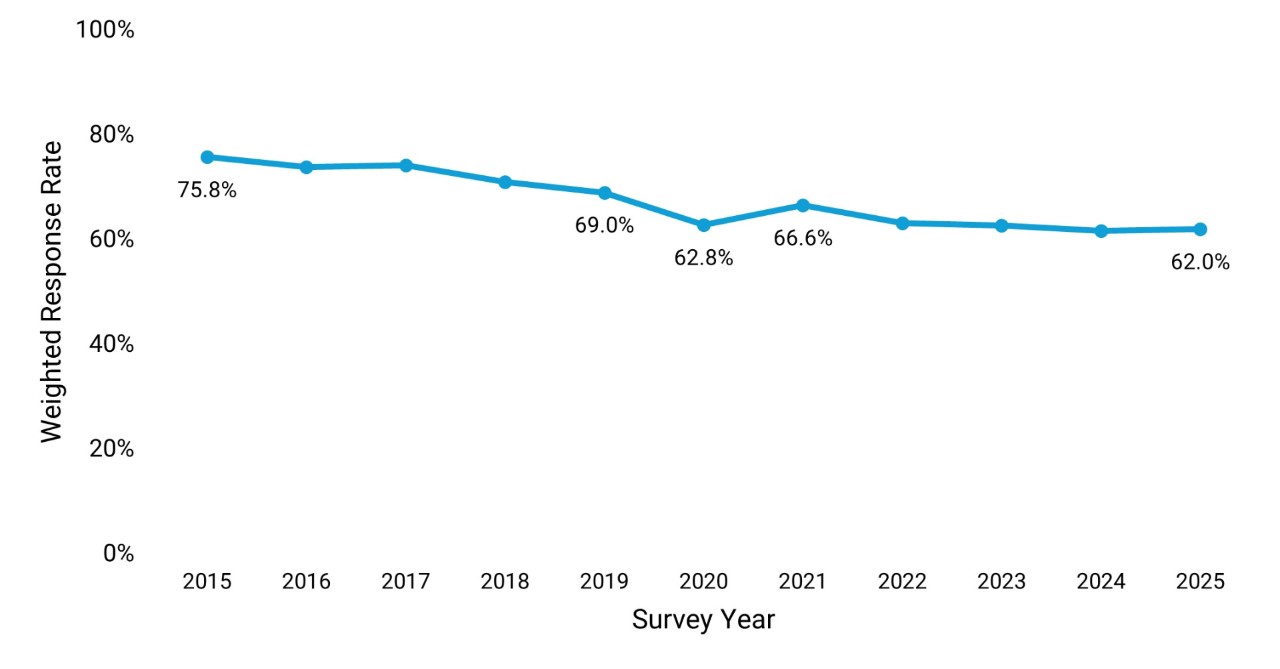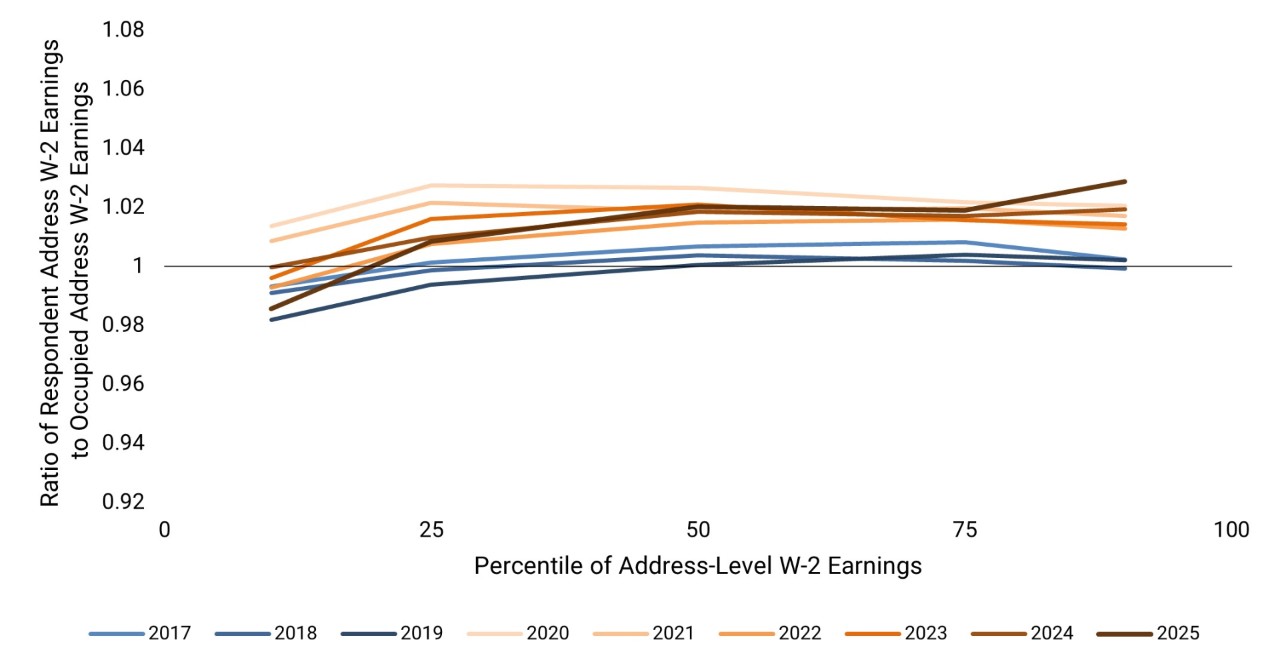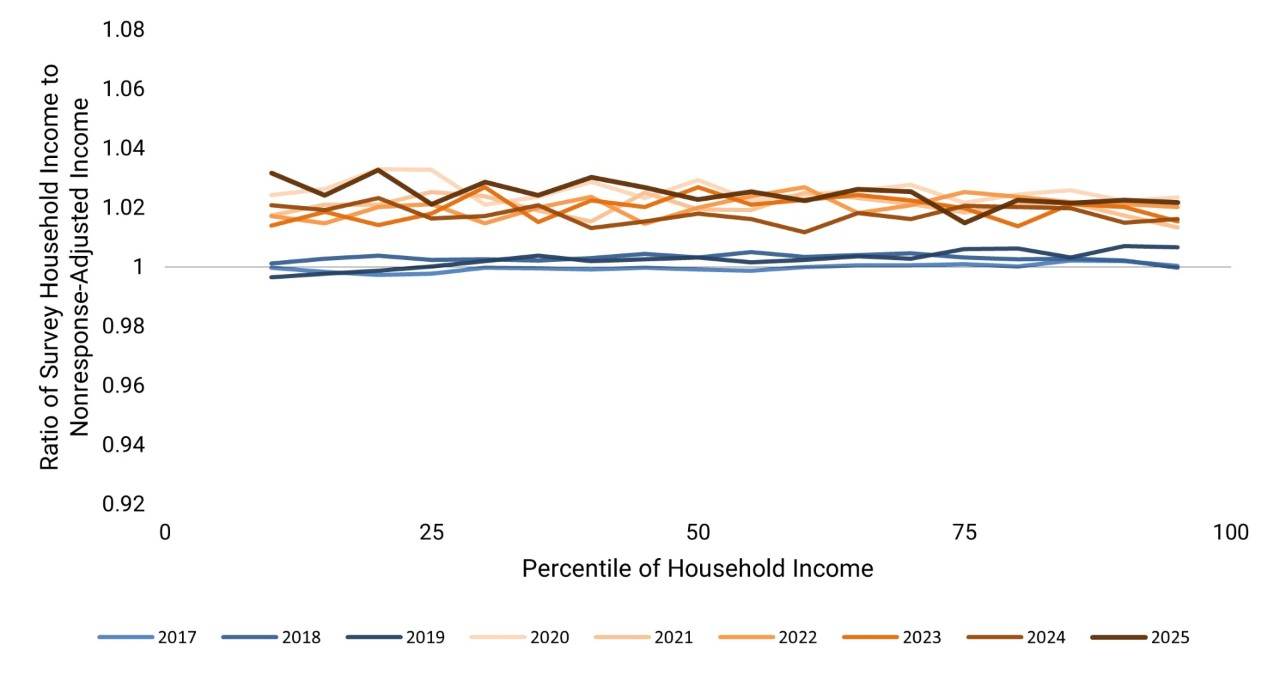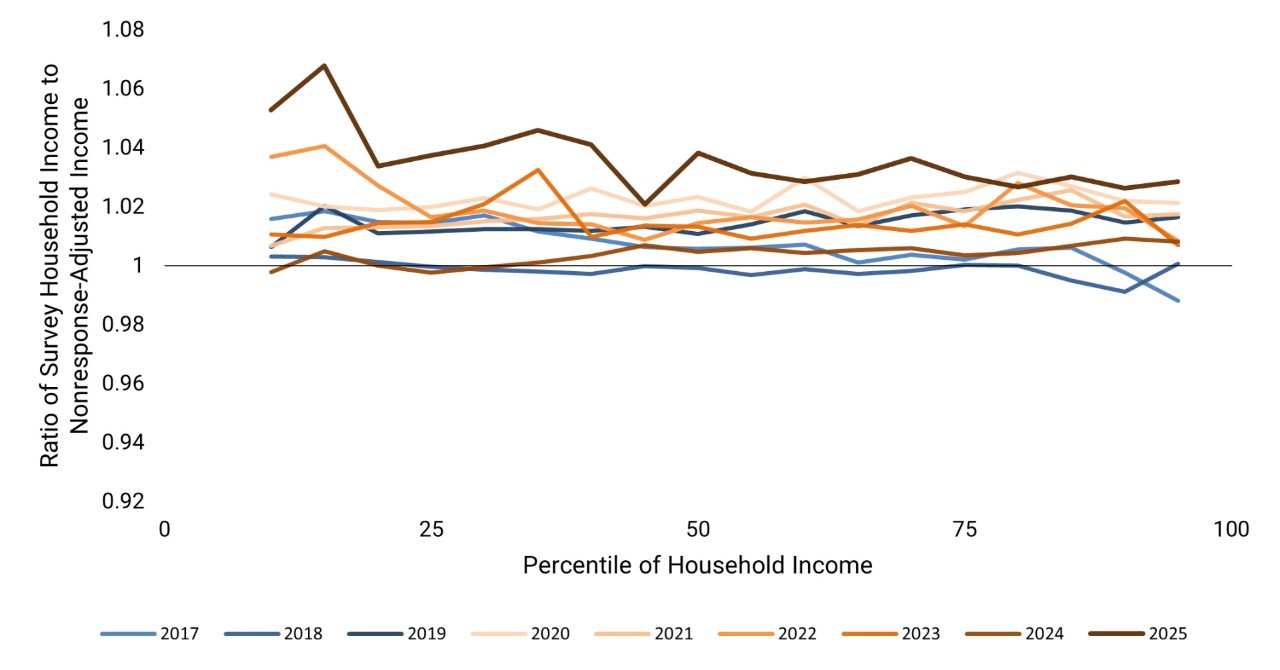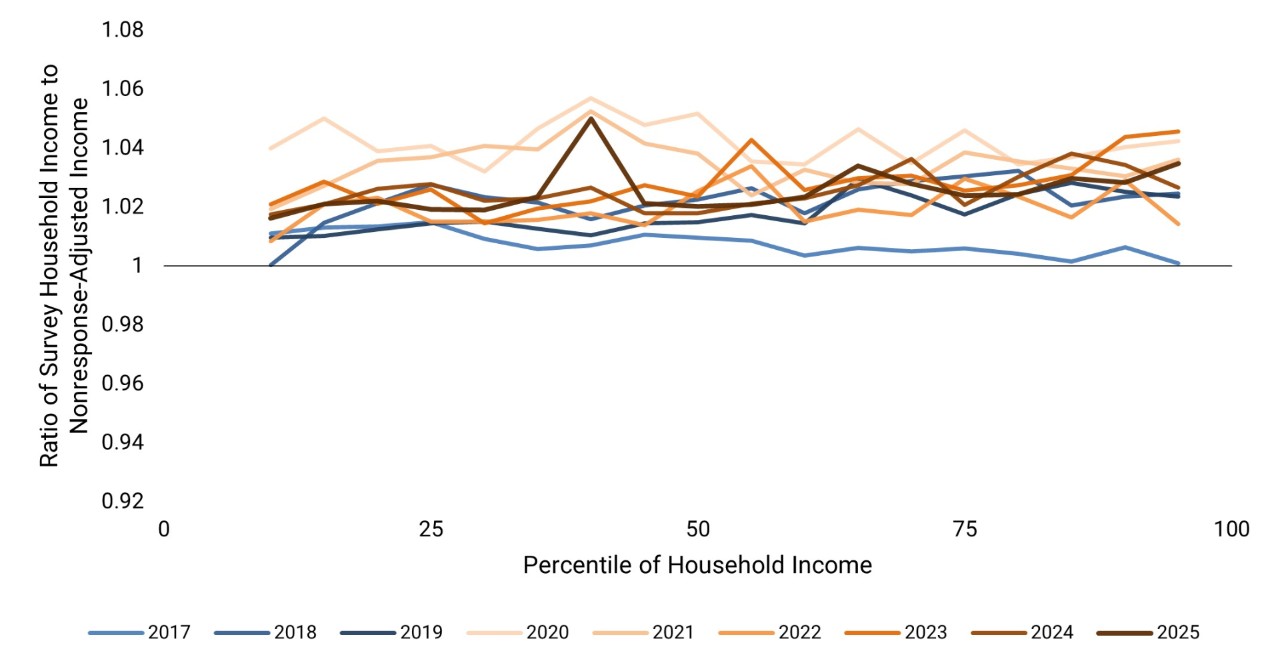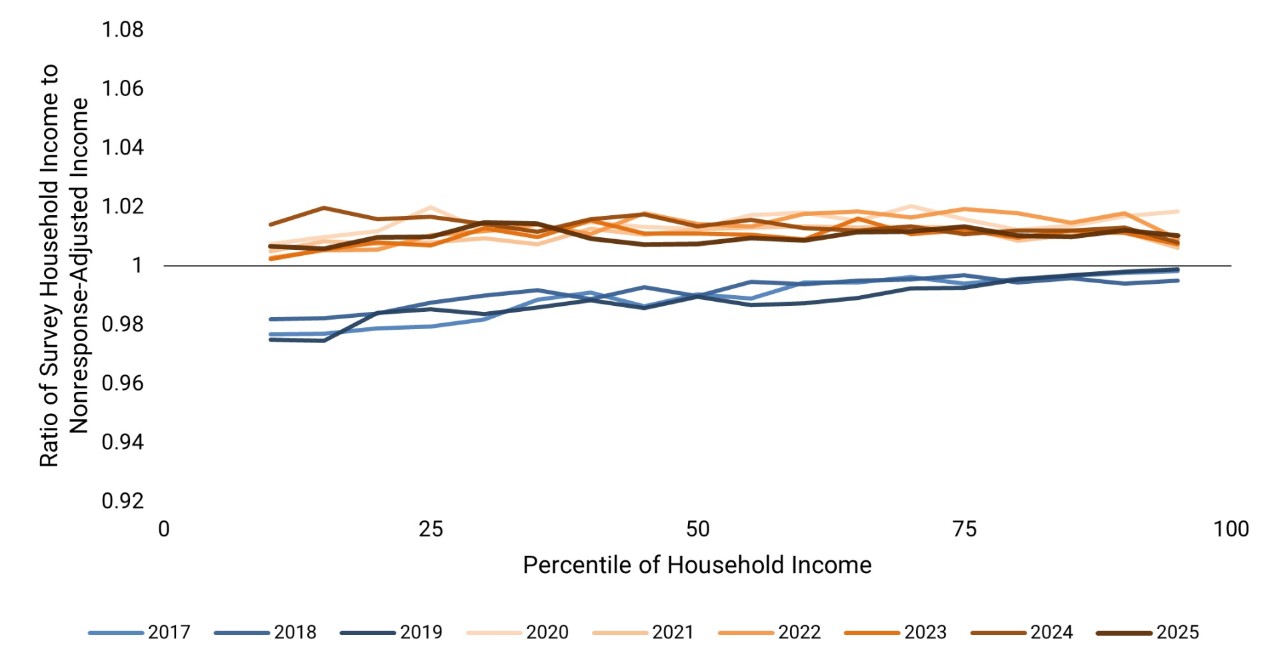Using Administrative Data to Evaluate Nonresponse Bias in the 2025 Current Population Survey Annual Social and Economic Supplement
Using Administrative Data to Evaluate Nonresponse Bias in the 2025 Current Population Survey Annual Social and Economic Supplement
In the latest release of its annual income report, Income in the United States: 2024, the U.S. Census Bureau tabulates the national income distribution using survey responses collected from February through April 2025 (with the majority of data collected in March) as part of the 2025 Current Population Survey Annual Social and Economic Supplement (CPS ASEC). However, as Research Matters blog posts from each of the last five years have explained (in 2020, 2021, 2022, 2023, and 2024), nonresponse in the CPS ASEC has biased income and poverty estimates.1 Nonresponse bias means that differences between those who respond to a survey and those who do not respond lead to an estimate that is less representative of the population.
Figure 1 plots weighted CPS ASEC response rates for 2015 through 2025. The weighted response rate for the 2025 CPS ASEC was 62.0%, compared to 69.0% in the 2019 CPS ASEC.
Lower response rates are not necessarily problematic if respondents and nonrespondents are similar, such that the resulting sample of respondents remains representative of the nation. To investigate this possibility, we combined administrative records, 2010 Census data, and American Community Survey responses to determine whether households that did and did not respond to the CPS ASEC systematically differed, and whether these differences biased the resulting income and poverty estimates.
Figure 2 plots earnings differences between survey respondents and the full sample of occupied addresses (including nonrespondents) using IRS Form W-2 records linked by address. It shows that in 2020 respondents began to have higher earnings than the population as a whole, whereas in earlier years the gap had been narrower.2 The phenomenon of disproportionately higher-earning respondents has repeated every year since 2020. Specifically, in each year from 2020 to 2025, the ratio of respondents’ median earnings to those of the full sample was significantly larger than the ratio in each of the years 2017 to 2019.
These differences between respondents and nonrespondents bias the resulting income statistics. We measure this bias by estimating a nonresponse adjustment that leverages information from linked data sources not available in standard survey processing.
Using alternative weights created from the alternative nonresponse adjustment, we calculate alternative income and poverty statistics and compare them to the official (survey-only) estimates. We find that estimates of median household income and poverty rates were not statistically different in 2017, 2018, or 2019. This indicates that in pre-pandemic years the normal nonresponse adjustment in the survey weights sufficiently addressed nonresponse bias for these statistics.
However, Figure 3 shows that since 2020 the alternative income estimates have diverged from those estimated using the CPS ASEC survey data alone. Figure 3 plots the ratios of the survey-only estimates to the nonresponse-adjusted estimates across the household income distribution. The horizontal line at 1 indicates the ratio at which the survey-only estimate would equal the alternative-weight estimate at that point in the distribution. Before 2020 these ratios hovered near 1, but since 2020 the survey-only income estimates have been about 2% to 3% higher than the alternative estimates, indicating upward bias.3
One key finding from recent Census Bureau economic measurement research is that biases can differ across groups, and these group-specific biases can themselves vary over time. For example, nonresponse bias among Hispanic households increased between 2024 and 2025: the median was biased upward by 3.8% in 2025, but the bias in 2024 was not statistically significant.4 Figure 4 displays the ratios between survey-only and nonresponse-adjusted income estimates for Hispanic households.
Figures 5 and 6 compare survey-only and nonresponse-adjusted distributions among Black households and non-Hispanic White households.
We also estimate alternative nonresponse-adjusted poverty rates among all families. In the 2020 to 2025 surveys, poverty rates were slightly — yet statistically significantly — lower than those yielded by alternative weights, by 0.5, 0.5, 0.3, 0.3, 0.4, and 0.4 percentage points respectively. These differences contrast with the pre-pandemic years 2017 through 2019, which showed no statistically significant differences in poverty rates between the alternatively weighted estimates and the survey estimates.5
To summarize, since the 2020 survey, nonresponse has continued to bias income statistics upward by 2% to 3% and official poverty rates downward by a fraction of a percentage point.
This work is part of a larger research agenda at the Census Bureau to develop and apply new methods to improve data quality. For example, the National Experimental Well-Being Statistics (NEWS) uses additional data from administrative and commercial sources, along with improved weighting and machine learning, to produce the best possible estimates of income and poverty. This research promises to address well-known challenges with our surveys and advance the Census Bureau’s commitment to serve as the country’s leading provider of quality data about its people and economy.
Definitions and information on confidentiality protection, sampling error, and nonsampling error are available at <https://www2.census.gov/programs-surveys/cps/techdocs/cpsmar25.pdf>.
1 More information about the design of the survey, including weighting for nonresponse, is available in Technical Paper 77 at <https://www2.census.gov/programs-surveys/cps/methodology/CPS-Tech-Paper-77.pdf> and in a summary of weighting in the CPS at <www.census.gov/programs-surveys/cps/technical-documentation/methodology/weighting.html>.
2 We refer to survey years in the text, tables, and figures to keep the references consistent and more clearly identify the 2020 to 2025 CPS ASEC surveys as the ones more affected by nonresponse bias. These surveys ask about income received in the previous year, however. Statistics from the 2020 CPS ASEC, for example, describe income received during 2019.
3 Specifically, since 2020 survey-only income estimates have been statistically significantly greater than the nonresponse-adjusted income estimates at all percentiles except for the 10th percentile in 2022 and 2023 and the 95th percentile in 2021.
4 We refer to household characteristics by the selected characteristics of the householder, the person (or one of the people) who owns or rents the home.
5 The differences between the survey and alternative nonresponse-adjusted poverty rates in 2020, 2021, 2022, 2023, 2024, and 2025 are each statistically significant, but the differences among those differences are not statistically significant.
